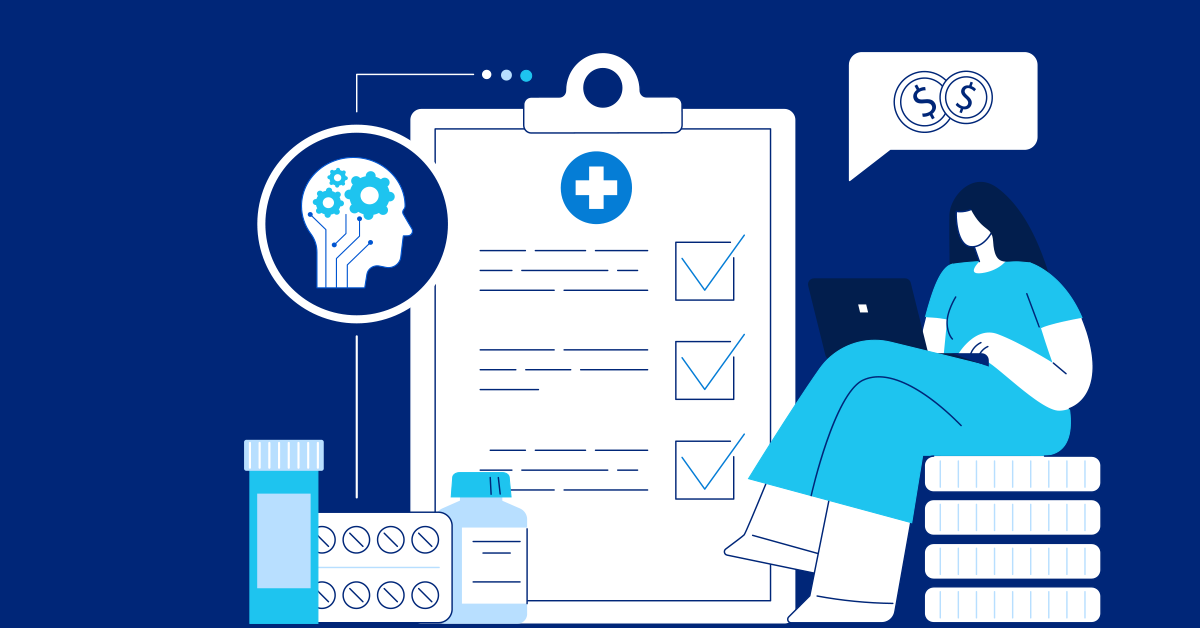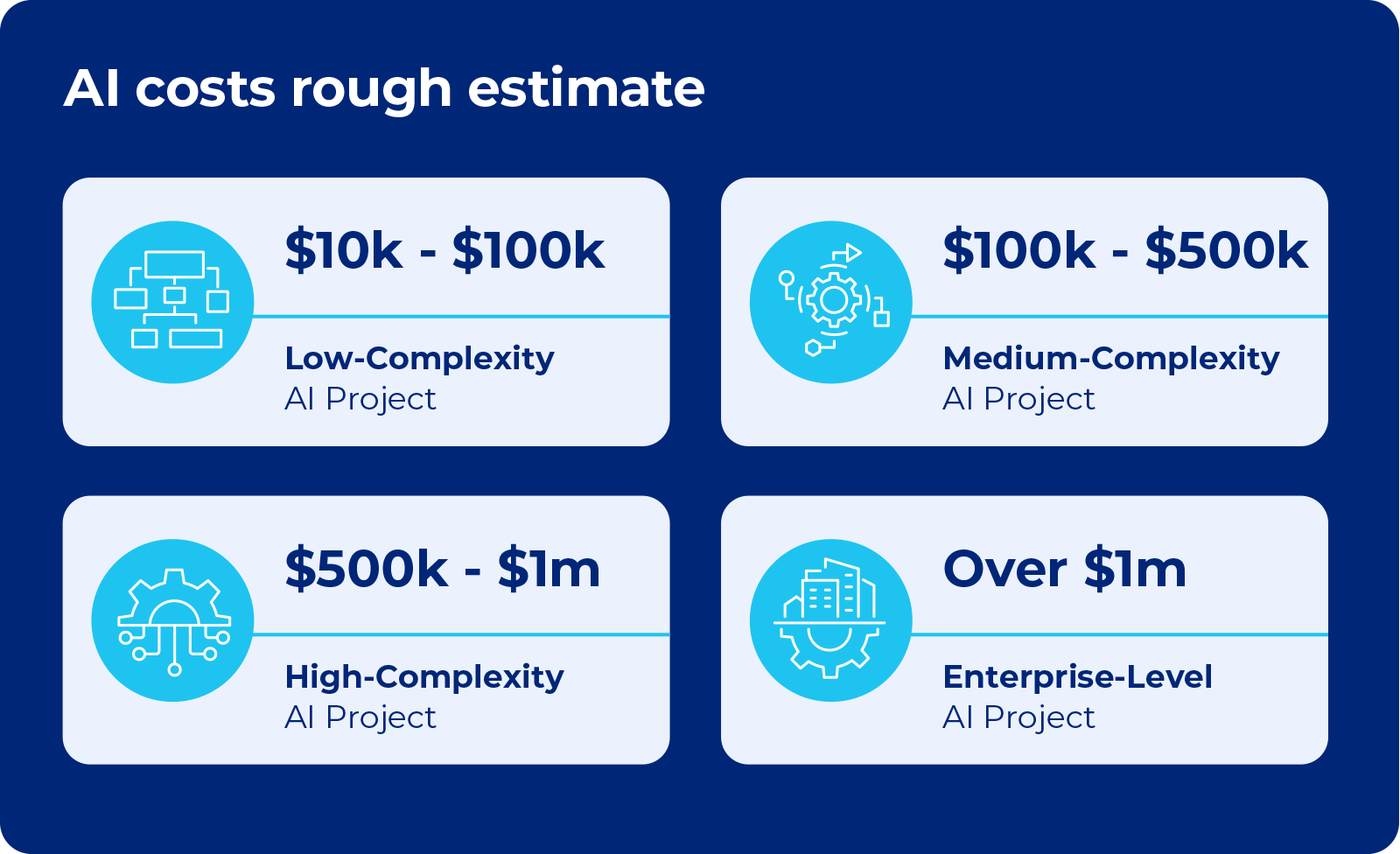In 2023, the net spending on artificial intelligence (AI) already surpassed 150 billion USD. Unsurprisingly, as per Statista reports, the financial sector and retail have invested the most, while healthcare is also among the domains where AI-powered solution integration seems all but unstoppable. As a result, the quality of diagnostics and treatment has been rising, but the cost of AI implementation is also an undeniable consideration.

The development and deployment of AI systems that healthcare providers utilize can cost as little as $20k for MVP and as much as $1m for a custom solution. It all depends on the organization’s budget, size, needs, and vision as AI is becoming increasingly accessible and unavoidable.
Read this comprehensive analysis and learn all you need to know about the factors that impact costs related to the implementation of artificial intelligence in healthcare and the strategies that can optimize the inevitable investment.
Factors Influencing the Cost of AI Implementation
1. Solution Complexity and Performance Requirements
AI projects vary a lot in terms of complexity, so the cost naturally depends on the type of AI applications. Areas like drug discovery, robot-assisted surgery, and tumor detection will always require much greater resources than fairly uncomplicated search engines, virtual assistants, or chatbots. The higher the quality and quantity of training data, algorithms, and expertise invested, the more the overall cost will rise.
2. Data Acquisition and Preparation
AI platforms are highly dependent on data and, ideally, on easily accessible, accurate, up-to-date, structured, and connected data that is required for model training. High-quality health data reduces the resources necessary for cleaning and processing the datasets, which is critical, especially with multiple data sources or vast volumes of paper records.
3. Team Composition and Expertise
AI development, deployment, and maintenance also require serious investment in a technical team comprising software engineers, data scientists, project managers, patient care domain specialists, etc. The size of the team and its expertise naturally impact the cost of AI implementation.

4. Infrastructure and Integration
When it comes to diagnostic imaging, surgical robotics, or genomics, the hardware and software structure needs to be top-of-the-line, which inevitably leads to heavy investment. Expenses go further up as high performance and frequent updates are pivotal to ensuring the smooth integration of AI with electronic health records (EHR) and other existing healthcare systems.
5. Regulatory Compliance and Security
The healthcare domain is subject to rigorous laws and regulations that AI solutions must comply with, including the Health Insurance Portability and Accountability Act (HIPAA) and General Data Protection Regulation (GDPR). This means additional investment in security measures, audits, and legal counsel to minimize the risk of fines.
6. Training, Validation, Maintenance
AI models’ precision, performance, and reliability are related to intense, time-consuming, and pricey training and updates. Ongoing maintenance and monitoring are also necessary to prevent potential compatibility and security issues.
Strategies for Cost Optimization
Many healthcare companies have found strategies to optimize the otherwise significant cost of AI implementation. This might seem an uphill task, but it is far from impossible, so read on and learn what the domain’s big players do to maximize the return on investment (ROI).
1. Prioritize and Phase Implementation
The development and deployment of comprehensive AI solutions in a single phase means massive upfront costs and efforts that are unlikely to spare any resources. Instead, setting priorities, adopting a phased approach, and starting with an MVP will significantly reduce the initial investment and give the company breathing space and perspective to evaluate and finetune the solution. That is why more businesses are looking into focusing on critical functionalities and iteratively expanding over time while addressing evolving requirements and technologies.
The Scalefocus AI Adoption Framework helps our clients adopt AI in small steps to achieve quick and measurable results. From planning and assessment to implementation, deployment, and governance, the Scalefocus experts lead our partners through the whole AI adoption process. A genuine blueprint for successfully building AI capabilities, this framework has ensured the seamless journey of multiple businesses from all domains into the AI world.
2. Leverage Existing Solutions and Hybrid Models
It is true that existing AI solutions may not completely meet a healthcare provider’s specific requirements, yet they can be utilized as a foundation for hybrid models. Leveraging an existing product’s suitable features at the initial stage and tweaking it at a later stage can be faster and more cost-efficient than developing a brand-new tool from scratch. Open-source AI frameworks and pre-trained models are also alternatives that can spare resources and speed up development and deployment.
3. Outsource AI Development and Management
Many healthcare organizations choose to outsource AI development and management to third-party vendors to leverage their superior tech expertise. AI outsourcing also reduces the investment related to hiring, training, and maintaining a reliable in-house team, pricey technology, infrastructure setup, etc.
Collaborations with an AI provider give access to world-class talent, the ability to scale up and down quickly, flexibility in responsibility and control, accelerated time to market, and budget predictability. Such partnerships can go beyond AI technology implementation, as Scalefocus’ impressive track record in partnering healthcare organizations has proved. Read all about it.

The Return on Investment: How to Unlock AI’s Transformative Potential
AI implementation comes at a cost, but its long-term benefits are hard to ignore. It only took a few years for AI to figuratively rewrite the rule book in about every aspect of modern life, including healthcare. From automated and streamlined clinical flows that alleviate the administrative burden on healthcare professionals to drug discovery, disease detection, and preventive care, artificial intelligence and machine learning have already revolutionized the whole domain, and there is no sign the transformation is slowing down any time soon.
Want to know a bit more about the challenges and solutions related to AI implementation in healthcare? Read our detailed analysis.
Conclusion
Solution complexity, meeting certain performance and data requirements, and hiring a team of experts are among the factors that impact the cost of implementing AI in healthcare. And then there are the expenses related to infrastructure, integration, regulatory compliance, security, updates, training, validation and maintenance. This means the upfront investment is indeed significant, but this is the price healthcare organizations have to pay to reap the multiple benefits of artificial intelligence.
Setting clear priorities, adopting a phased approach, and kicking the project off with a moderately priced MVP can significantly reduce the cost of AI implementation. Taking advantage of solutions that have already been in use and incorporating them within hybrid technology models is also among the optimization strategies that help healthcare companies reduce the initial investment.
Last but not least, outsourcing AI development, deployment, and management to experienced vendors with formidable expertise is a proven method for resource optimization. Furthermore, such collaborations with AI providers like Scalefocus give access to top talent and cutting-edge technology, which can only benefit your AI solutions. Our experts can help you build an AI implementation strategy, develop a world-class solution, and tailor it to your business needs while optimizing all related costs.
Book a meeting with our experts so we can discuss your AI-related challenges and how we can address your business case. We look forward to hearing from you!



